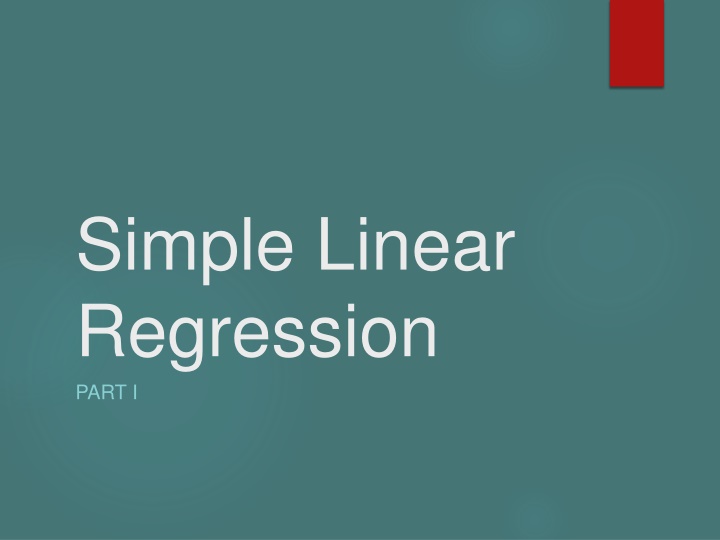
Regression Analysis for Striped Sweater Itchiness
Delve into the world of regression analysis to explore the relationship between the number of stripes on a sweater and its itchiness. Discover how to calculate regression equations, predict itchiness levels, and interpret the impact of additional stripes. Explore the practical application of regression in analyzing sweater data and gain insights into SPSS regression analysis.
Download Presentation

Please find below an Image/Link to download the presentation.
The content on the website is provided AS IS for your information and personal use only. It may not be sold, licensed, or shared on other websites without obtaining consent from the author. If you encounter any issues during the download, it is possible that the publisher has removed the file from their server.
You are allowed to download the files provided on this website for personal or commercial use, subject to the condition that they are used lawfully. All files are the property of their respective owners.
The content on the website is provided AS IS for your information and personal use only. It may not be sold, licensed, or shared on other websites without obtaining consent from the author.
E N D
Presentation Transcript
Simple Linear Regression PART I
The best time to wear a striped sweater is Does the number of stripes in a sweater affect the itchiness of a sweater? I tried on 50 sweaters at local retailers (e.g., The Gap; PacSun; Stripes R Us). I gave each sweater an itchiness rating on a 10-point scale (higher values equal greater itchiness) and also counted the number of stripes. The sweaters ranged from 2 to 11 stripes (because you can t have one stripe). Calculate the regression equation from the data in the table below. X2 Y2 X*Y Y: Itchiness X: # of Stripes = 350 = 300 = 2950 = 1982 = 1850
Striped sweater regression line 1. Are more stripes associated with more or less itchiness? Is the relationship between stripes and itchiness direct or inverse? 2. Calculate the predicted itchiness for a sweater with 18 stripes. Is this value meaningful? 3. If I learned how to knit and added an additional stripe to a sweater from my sample, how much would I expect its itchiness rating to change?
Striped sweater regression line X2 Y2 X*Y X: # of Stripes = 350 Y: Itchiness = 300 = 2950 = 1982 = 1850 (x2) [( x)2 / n] 2950 [(350)2 / 50] 2950 (122500 / 50) 2950 2450 SSx = = = = 500 = (xy) [ (x) (y) / n] 1850 [(350)(300) / 50] 1850 (105000 /50) 1850 2100 SP = = = = = -250
Striped sweater regression line X2 Y2 X*Y X: # of Stripes = 350 Y: Itchiness = 300 = 2950 = 1982 = 1850 SSx SP = = 500 -250 b = = = SP / SSx -250 / 500 -0.5 = 9.5 0.5(X) a = My (b* Mx) = = 6 (-.5)(7) 9.5
Striped sweater regression line = 9.5 0.5(X) 1. Calculate the predicted itchiness for a sweater with 18 stripes. Is this value meaningful? = 9.5 0.5(X) = 9.5 0.5(18) = 0.5 2. If I learned how to knit and added an additional stripe to a sweater from my sample, how much would I expect its itchiness rating to change? I would expect it to be .5 units less itchy b/c the slope is -0.5.
Striped sweater regression in SPSS Analyze Regression Linear
Striped sweater regression in SPSS 1. Slide the DV into the Dependent box. 2. Slide the IV into the Independent(s) box. Which is which? 3. Click OK.
Predicting COVID violations Use the data we collected in class last time to determine whether any of the variables we collected predict COVID violations? Analyze Regression Linear One variable at a time Is COVID violations going to be the dependent or independent variable?
World Happiness data Part II What are some reasonable questions to ask about this dataset? Tell me the story of this data set. Perform some correlation regression analyses to help us understand what predicts happiness.
World Happiness data Part II What are some reasonable questions to ask about this dataset? Tell me the story of this data set. Perform some correlation regression analyses to help us understand what predicts happiness. Compare the results from the correlation and regression analyses. What does this comparison suggest?
-What is R2? -What is the standardized slope? -What does the standardized slope suggest about change in X vs. Y?
-Is self-esteem more strongly related to positivity or to negativity? -Calculate and interpret R2 for the association between self-esteem and positivity
Predicting Happiness Use the data in the happiness data set to determine whether any of these variables predict happiness? Analyze Regression Linear One variable at a time
